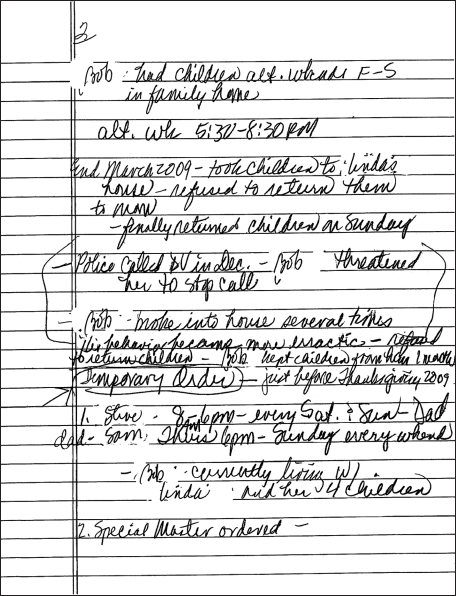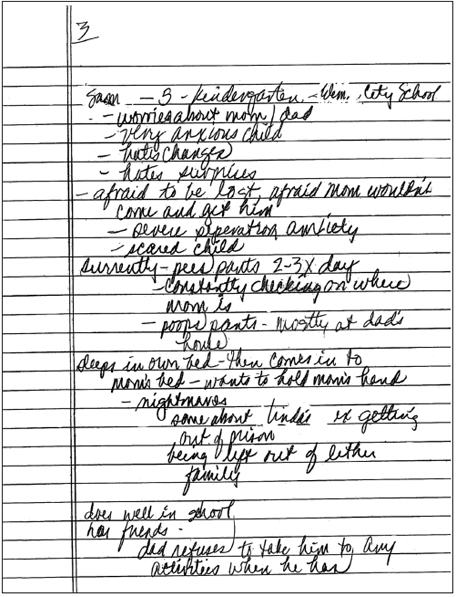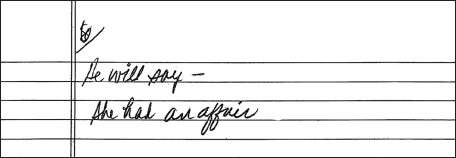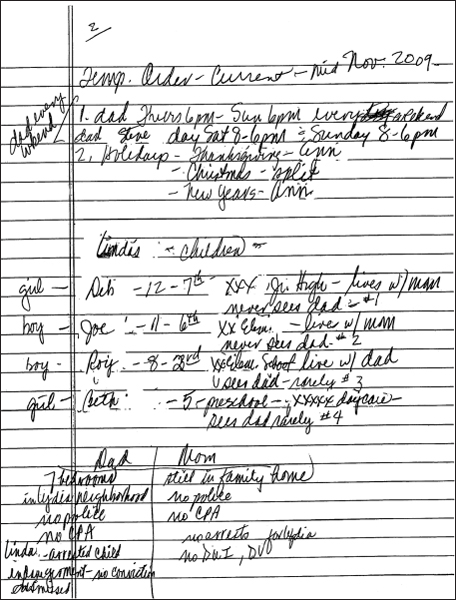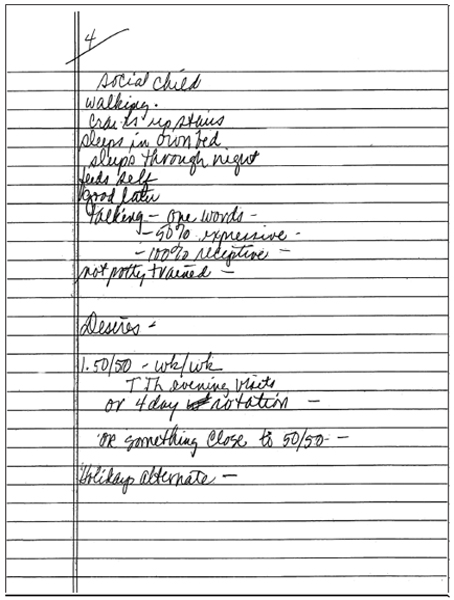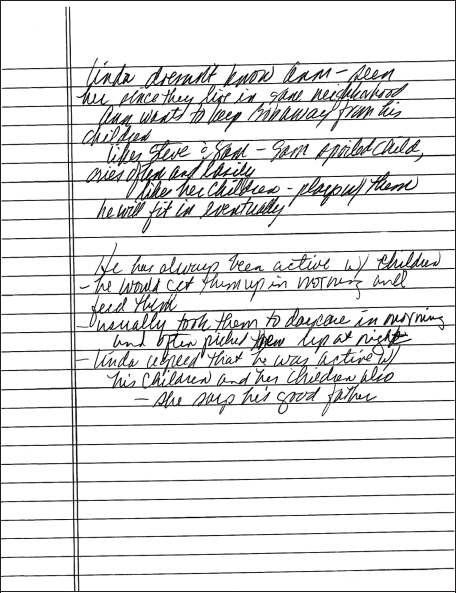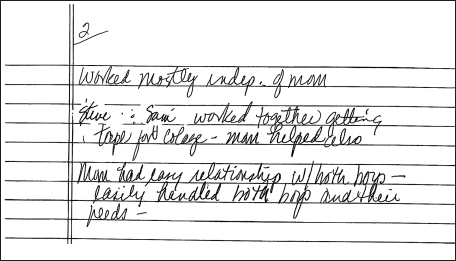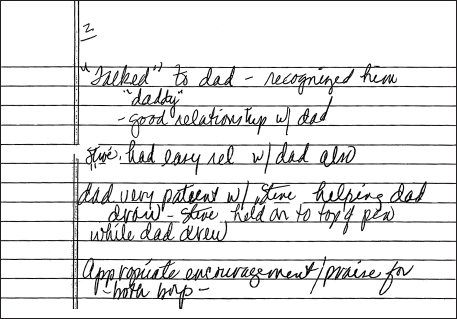Working Through a Case

9
Working Through a Case
Let’s try working through an actual case. At this point, you understand what to look for when conducting interviews and reviewing notes, listening with your counseling ear to hear not only what the person says but the meaning behind his or her words. You are hearing his or her story, but also his or her feelings and motives. It is your job to collect enough information to paint the picture of this family while they were together and now that they are apart.
You are the child’s voice in court. It is your job to help the court issue the best possible order of custody and visitation for the child. Your professional experience and opinion will help set the direction for this child’s life, emotional well-being, and positive development. It is a big responsibility.
Remain calm, cool, and collected throughout this process. Don’t jump to conclusions before you have all the information you need to make reasonable recommendations. Don’t become emotional, dramatic, or excessive. Remember that these people are coming to you engaged in a high-conflict situation: They are going to be angry, sad, vengeful, and not particularly introspective.
Now read this actual case. The names have been changed to protect the participants’ identities. Dates have also been changed, but the time between appointments and so forth remain consistent with what actually happened. The notes are handwritten, having been produced during interviews. As with all case studies, some information is missing because you weren’t there to experience the sessions. After some questions for you to consider, any pertinent information that has not been given will be provided to give you a better understanding of what happened during the sessions. Afterward, read the recommendations that were provided to the court and compare them to your own.
THE CASE OF SMITH VS SMITH
RE: SMITH VS SMITH
CASE NO.: CV-2010-0000-DR
DATE: JANUARY 1, 2010
A court order, a generic order appointing an evaluator, arrived in your mail on January 5, 2010. Both parents involved in the case, Ann Smith and Bob Smith, have contacted your office to set up appointments for their evaluations, using the contact information provided on the court order. The names and addresses of both attorneys were also included, along with the name of the judge assigned to this case. In short, the order gives you the authority to talk with anyone, and collect any information, deemed relevant to making recommendations concerning the custody and visitation of the minor children. As the evaluator assigned to this case, you will interview both parties, the minor children, and any other pertinent collateral contacts, as well as review school, medical, mental health, and any other records requested. Additionally, you will convey your recommendations to the court as soon as possible and refrain from ex parte communication with attorneys. The cost of the evaluation will be split equally between the parties and the cost of court testimony will be borne by the requesting party.
MOTHER’S INTERVIEW
The first appointment was on January 22, 2010. The mother, Ann Smith, came to the office alone for her interview. The interview started with a discussion about the lack of confidentiality in legal cases, what to expect from this interview, and the purpose of the interview. Discussion of money (already done once on the phone when the appointment was set up) and the future appointment with the mother and the children took place in more detail at the end of the interview. In addition, the evaluator clarified the names and ages of the children, the name of the mother’s attorney, the name of the father’s attorney, and whether the mother or the father was currently living with anyone who was providing stepparenting for the children. All these details were also discussed when the appointment was established.
The following notes were generated during Ann’s interview and will tell much about Ann, her parenting abilities, and her perspectives on the children and her soon-to-be ex-husband. Read them and then think about what you have read before you answer the questions that follow. At the end of the interview, Ann paid for her share of the evaluation and was given a receipt. There was a discussion about what this money paid for and what other costs might be incurred if the evaluator was asked to actually testify in court. An appointment was set up for Ann to bring the children. There was a discussion about what to tell the children about why they were coming to see the evaluator and about what was going to happen during the session with the children while they were with their mother and when they were alone with the evaluator. Also discussed was the process the evaluator followed in submitting the recommendations to the attorneys and the court and a probable timeline for completion of the case. Ann was asked whether she wanted to say anything else or talk about anything not already discussed. The interview with Ann lasted 2 hours:
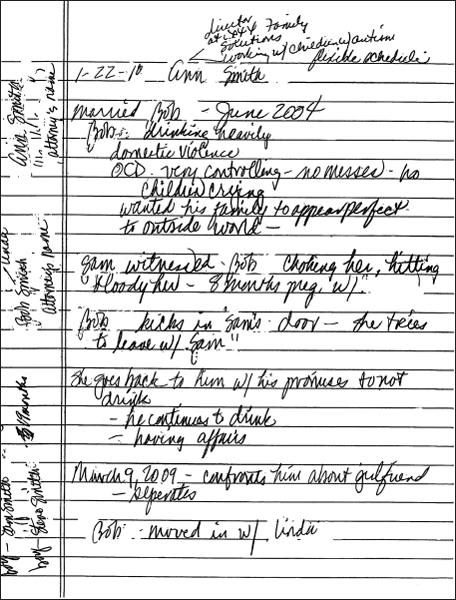
Questions to Consider: Mother
Here are some questions to consider after reading the notes generated during the mother’s interview. Remember: These do not tell the entire story—just Ann’s side of it.
1. What, in Ann’s perspective, was the family like prior to the breakup?
2. How would you describe the relationship Ann and Bob had during their marriage?
3. Who was the primary caregiver during the marriage?
4. Were alcohol or drugs a problem in the marriage?
5. Was either parent unfaithful during the marriage?
6. Why did they separate?
7. What were the arrangements for visitation after the separation?
8. Where are the parents currently living?
9. Are there any temporary visitation orders in place?
10. Are the temporary orders working for the children?
11. What is Sam (the oldest child) like? How does his mother describe him? What are her concerns about Sam?
12. What is Steve (the youngest child) like? How does his mother describe him? What are her concerns about Steve?
13. How does Ann describe Linda (the stepparent)? How do the children get along with Linda?
14. What are Ann’s desires for custody and visitation for the children?
15. What are the chances of Ann and Bob becoming reasonable coparents?
Now that you have answered the questions, let’s see how closely your answers match the evaluator’s. Remember: You are at a disadvantage since you weren’t at the interview. However, your responses to the questions might be as valid as or even better than the evaluator’s answers—in any case, there should be some similarity between your responses and the evaluator’s.
Questions to Consider: Mother/Evaluator’s Answers
1. What, in Ann’s perspective, was the family like prior to the breakup?
The relationship between Ann and Bob was not a serene one. There was domestic violence against Ann by Bob even in front of the oldest child. To the outside world, the relationship appeared a good one: Both parents were educated and employed and raised the children as a unit. However, as in many relationships, the reality of the family was significantly different behind closed doors. Ann behaved as is often common for a victim of domestic violence, becoming pregnant with a second child and believing Bob when he said that he would never hit her again, that he would stop drinking, and so forth. Ann tried to save the marriage for as long as she could, but when she found out about Linda, she confronted Bob about the affair. It was then that Bob moved out of the family home and into Linda’s home.
2. How would you describe the relationship Ann and Bob had during their marriage?
The relationship was one of some good times but many bad. Bob drank to excess and became violent. He choked Ann, hit her, and engaged in other physical attacks, such as breaking doors and hitting walls.
3. Who was the primary caregiver during the marriage?
Ann was the primary caregiver of the children, but Bob did interact with the children. He would take them to child care and pick them up. But he also physically abused Ann in front of their oldest son.
4. Were alcohol or drugs a problem in the marriage?
Ann calls Bob an alcoholic. She further claims that when he drank he drank until he was intoxicated and became violent with her—but not the children.
5. Was either parent unfaithful during the marriage?
Ann claims that Bob was unfaithful during the marriage and is now living with his girlfriend and her four children.
6. Why did they separate?
There were two good reasons: the domestic violence and the girlfriend. Ann separated from Bob when she discovered the girlfriend.
7. What were the arrangements for visitation after the separation?
Originally, Bob had the children on alternate weekends from Friday to Sunday in the family home. Ann left the home when he cared for the children. Eventually, he took the children to where he was living with Linda and kept them there with him. Ann claims he wouldn’t return the children until the end of his weekend visitation. A temporary order was issued just before Thanksgiving: Bob was to have visitation with the youngest child, Steve, every Saturday and Sunday from 8 a.m. to 6 p.m. He would have Sam, the oldest child, every Thursday to Sunday. Ann had no weekends with the children under the terms of the temporary order.
8. Where are the parents currently living?
Ann currently lives in the family home; Bob lives together with his girlfriend and her four children.
9. Are there any temporary visitation orders in place?
The temporary orders mentioned in point 7 have been in effect for approximately 2 months.
10. Are the temporary orders working for the children?
The oldest child is suffering from the breakup of the family. Sam has regressed in several ways, including by urinating and defecating in his pants, showing anxiety away from his mother, exhibiting clingy behaviors with his mother, and experiencing nightmares. The youngest child shows some separation anxiety from his mother but generally does fine during day visits with his father.
11. What is Sam (the oldest child) like? How does his mother describe him? What are her concerns about Sam?
Sam is an anxious child. He worries most of the time about his mother and father and the breakup of his family. His anxiety often exhibits as urination or defecation in his pants. He does not like change and needs time to incorporate change into his life. He is struggling right now and is seeing a counselor. He does do well in school, and he has friends.
12. What is Steve (the youngest child) like? How does his mother describe him? What are her concerns about Steve?
Steve is a happy baby. He attends daycare at a licensed child care facility. He is walking and speaking single words. He has good receptive language and understands some sign language.
13. How does Ann describe Linda (the stepparent)? How do the children get along with Linda?
Let’s face it—Ann is not a fan of Linda, whom she describes as a woman whose four children all have different fathers. Linda moves herself and her children often and has moved with Bob two times already in their short time living together. Nude pictures of Linda are available on the Internet. Linda also has no functional stepparenting philosophy. She disciplines Sam and allows her 13-year-old daughter to babysit five children while she and Bob go out. She tries to instigate fights with Ann and does drive-bys of Ann’s home.
14. What are Ann’s desires for custody and visitation for the children?
Ann wants the children to visit their father on alternate weekends from Friday evening to Sunday evening. On the nonweekend visitation weeks, she would like the children to have short evening visits with their father. She wants the visits with Steve to continue to be day visits on alternate Saturdays and Sundays. Holidays can be alternated. Summer visitation would remain the same as during the school year. She also wants Sam to continue to sleep in the upstairs bedroom next to his father’s room when he stays overnight with his father.
15. What are the chances of Ann and Bob becoming reasonable coparents?
It’s hard to say at this point without meeting with Bob and Linda. Ann appears to be somewhat dramatic and quite protective of the children but is reasonable and somewhat flexible. She understands the importance of the children’s father in their lives.
FATHER’S AND STEPPARENT’S INTERVIEW
The next appointment was with the father, Bob Smith, and his current live-in significant other (referred to as the stepparent), Linda. Their appointment was on January 29, 2010. Bob Smith and Linda came together for their appointment. The interview started with a discussion about the lack of confidentiality in legal cases, what to expect from this interview, and the purpose of the interview. Discussion of money (already done once on the phone when the appointment was set up) and the future appointment with the father and the children took place in more detail at the end of the interview. The evaluator clarified the names and ages of the children, the name of the father’s attorney, the name of the mother’s attorney, and whether Bob thought Ann was currently living with anyone who was providing stepparenting for the children. All these details were also discussed when the appointment was established.
Bob was also a reasonable person and presented himself well. He spoke clearly and effectively. He was also eager to tell his side of the story. He admitted that he believed that the courts were against him by default because he was a man. There was a discussion about how that might have been true in the past but how, in today’s family courts, fathers have the same rights and responsibilities as mothers. The evaluator also discussed the outcome of some previously evaluated cases and how in them the fathers were treated fairly in the court. Bob did not appear to be under the influence of drugs or alcohol. He communicated well and was easy to talk with.
Linda was also dressed appropriately and appeared reasonable. She often spoke for Bob and helped him remember dates of events discussed during the interview. She seemed to be very knowledgeable about Bob’s life with Ann, his children, and possible solutions to Bob and Ann’s problems. She communicated well but did remain quiet when she was given cues by the evaluator to remain quiet and let Bob talk. Bob and Linda sat close together and often touched each other and held hands during the session.
The following are notes generated during Bob and Linda’s interview. The notes will tell much about Bob’s perspective on his parenting, Ann’s parenting, and their children. The notes also talk about Linda’s family and what she brings to this new family. At the end of the interview, Bob paid for his portion of the evaluation and was given a receipt. Discussion of other costs was conducted. An appointment was set up for Bob to bring the children, and the evaluator discussed what to expect during that appointment. Bob was also asked whether he wanted to talk about anything else not already mentioned. The appointment lasted 2 hours:
Father/Stepparent Interview Notes
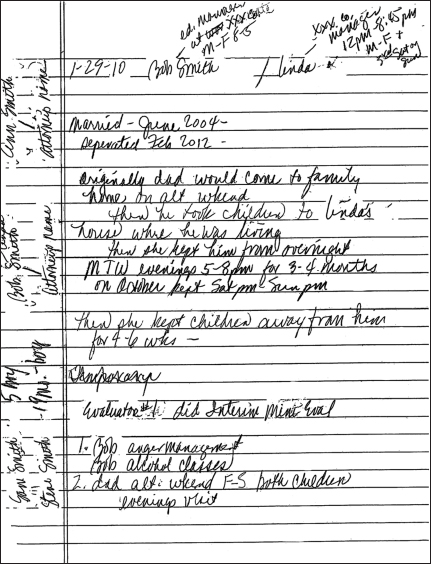
Questions to Consider: Father and Stepparent
Here are some questions to consider after reading the notes generated during Bob and Linda’s interview. Remember: These do not tell the entire story—just Bob’s side of it.
1. What, in Bob’s perspective, was the family like prior to the breakup?
2. How would you describe the relationship Ann and Bob had during their marriage?
3. Who was the primary caregiver during the marriage?
4. Were alcohol or drugs a problem in the marriage?
5. Was either parent unfaithful during the marriage?
6. Why did they separate?
7. What were the arrangements for visitation after the separation?
8. Where are the parents currently living?
9. Are there any temporary visitation orders in place?
10. Are the temporary orders working for the children?
11. What is Sam (the oldest child) like? How does his father describe him? What are his concerns about Sam?
12. What is Steve (the youngest child) like? How does his father describe him? What are his concerns about Steve?
13. How does Linda describe Ann? How well does she get along with Ann?
14. What are Bob’s desires for custody and visitation for the children?
15. What are the chances of Ann and Bob becoming reasonable coparents?
16. How do the children relate to Linda?
17. What is Linda’s stepparenting philosophy?
18. Do Bob and Linda have reasonable expectations for a successful blended family?
19. Between Bob and Linda, who provides most of the parenting when the children are at Bob’s house?
20. What is the relationship like between Bob and Linda?
Now let’s compare your answers with those of the evaluator. You are getting the idea that there are always two sides to the story—and that they are generally different in high-conflict cases. Never make your mind up about your recommendations until you hear all sides and gather enough information to validate the recommendations you do make.
Questions to Consider: Father and Stepparent/Evaluator’s Answers
1. What, in Bob’s perspective, was the family like prior to the breakup?
The notes do a fairly good job detailing what Bob thought about the marriage before the breakup. He thought Ann was controlling and would try to run the family. They got along all right, but he had a great deal of responsibility for child care in the family. He fed the children breakfast each morning and took them to daycare. He often put them to bed at night. He described himself as a hands-on father. He grew tired of Ann’s constant nagging and talked to Linda about his marriage. He denied having an affair with Linda—he says that they weren’t intimate until they began living together.
2. How would you describe the relationship Ann and Bob had during their marriage?
Bob denied being an alcoholic, though he said he drank a few drinks occasionally. He described Ann as being overly dramatic when it came to his drinking. He denied ever hitting her or breaking anything when he was drinking. There are no police reports or arrests pertaining to the alleged domestic violence. Bob said the marriage started out good but went downhill after Sam was born: He and Ann grew apart.
3. Who was the primary caregiver during the marriage?
Bob suggested that he was the primary caregiver, but the evaluator didn’t buy his argument for that role. However, he was involved in parenting the children.
4. Were alcohol or drugs a problem in the marriage?
Bob denies that drugs or alcohol were ever an issue in the marriage. He has no arrests or DUIs, and no police reports recording calls to the home for domestic violence.
5. Was either parent unfaithful during the marriage?
Bob said he was not unfaithful during the marriage. He moved in with Linda soon after leaving the marriage, but he wasn’t “with” Linda until they began living together. Bob is concerned about Ann’s current boyfriend, who has a recorded DUI and a background of domestic violence. He also speaks maliciously about Bob on Facebook.
6. Why did they separate?
Bob’s reason for the separation had nothing to do with domestic violence, alcoholism, or infidelity. He just didn’t want to be with Ann anymore.
7. What were the arrangements for visitation after the separation?
He generally agreed with what Ann said about the visitation arrangements after the separation. He did say that he took the children to Linda’s house and didn’t return them to Ann when she requested. He said that he didn’t have to do what Ann told him to do—they were his children, too. Things have gotten better since the temporary order, because now he and Ann can’t fight about who has the children and for how long.
8. Where are the parents currently living?
Ann is currently living in the family home, and Bob is living with Linda and her four children in a home they rent. He did acknowledge that they have moved two times but said that they are now situated in a home that is large enough for all the children and that is located in the same neighborhood as the original family home.
9. Are there any temporary visitation orders in place?
Yes, and the parents agree on what the orders say.
10. Are the temporary orders working for the children?
Bob thinks they are, but he thinks they could be improved by allowing the children to spend more time with him. He also wants overnights with his youngest son.
11. What is Sam (the oldest child) like? How does his father describe him? What are his concerns about Sam?
Bob describes Sam as doing well in school and having friends. He also says that Sam lies about everything and thus can’t be believed when he tells stories. Bob agrees that Sam urinates in his pants but says he doesn’t defecate in them. Bob says that Sam is a picky eater and a picky child. Sam worries a lot about things and doesn’t like changes in his routine.
12. What is Steve (the youngest child) like? How does his father describe him? What are his concerns about Steve?
Bob describes Steve as a happy child. He is walking and sleeps in his own bed through the night. He can crawl up stairsteps. He can feed himself. He talks in single words and has good receptive language.
13. How does Linda describe Ann? How well does she get along with Ann?
Linda thinks Ann is jealous of the relationship that she and Bob share. She really doesn’t know Ann and doesn’t want to know her. She thinks Ann is hypervigilant about the children.
14. What are Bob’s desires for custody and visitation for the children?
Bob wants both children for half the time. He would like a week/week rotation but would consider a 4-day rotation. He also wants evening visits with the children on the weeks when Ann has the children. Holidays could be alternated.
15. What are the chances of Ann and Bob becoming reasonable coparents?
The jury is still out on that question. Bob does not really want to communicate with Ann. He does not like her to tell him what to do when it comes to his time with the children. However, he is able to talk with her effectively on occasion.
16. How do the children relate to Linda?
Linda describes everything as being fine when the children are with her and Bob. She gets along well with Bob’s children, and they get along great with her children.
17. What is Linda’s stepparenting philosophy?
She treats them like her own children. She doesn’t show favoritism to any of the children. She is very involved in her older children’s extracurricular activities. The family attends these children’s competitions almost every weekend.
18. Do Bob and Linda have reasonable expectations for a successful blended family?
They describe what they think is already a successful blended family.
19. Between Bob and Linda, who provides most of the parenting when the children are at Bob’s house?
Linda provides most of the parenting, but Bob is also actively involved. Linda works a late shift, so Bob is responsible for the children in the evenings and before bedtime. He also attends Linda’s children’s weekend competitions. He is trying to balance his life with six children and a new relationship.
20. What is the relationship like between Bob and Linda?
It appears that Bob and Linda have a committed relationship to each other now. Statistically, such relationships do not generally succeed, but for now it appears that Bob and Linda are committed to each other. Linda orchestrates the family, including what Bob is expected to do in it. Linda is protective of Bob, as he is of her.
REVIEW OF INFORMATION GATHERED FROM PARENT INTERVIEWS
Now that the evaluator has met with both parents, let’s compile what we know, what we don’t know, and what we want to verify with other contacts. There is still a long way to go before you write the recommendations, but the picture is beginning to become more detailed.
What we know is that both parents seem to be reasonable people. They disagree on what would work best for the children when it comes to custody and visitation, but they appear to both love the children very much and want what is best for them. We also know that neither parent communicates well with the other parent nor particularly wants to talk with the other parent. Ann is likely to coparent more effectively than Bob, at least in the beginning. Both parents describe the children similarly, especially Steve. They do agree that Sam is an anxious child, doesn’t handle change well, does well in school, and has friends. They both agree that he is struggling with the breakup of the family.
What they disagree on is the role of Bob’s drinking in the ultimate demise of the family. Ann talked at length about Bob’s alcoholism; Bob denied there was any problem. Ann talked about the domestic violence that occurred in the marriage; Bob denied there was ever domestic violence. Ann reported that Bob was controlling; Bob claimed Ann was bossy and controlling. Ann thinks that Bob was having an affair with Linda prior to the breakup of the marriage; Bob says this is untrue. They do not agree on Sam’s regression: Ann says Sam urinates and defecates in his pants; Bob says Sam only urinates in his pants. Ann says Sam doesn’t get along with Linda and her children. Bob insists that Sam and Steve get along very well with Linda and her children.
What we still don’t know is whether the drinking and domestic violence should play a significant role in the recommendations: There have been no arrests or police involvement. It really is her word against his. Bob also says that Sam is a liar and tells stories that are not true, though Ann did not describe her son that way. The evaluator will have access to the report that was written previously about this case, and that may or may not clarify some of these unknowns. We also don’t know how Sam relates to Linda and her children. The parents describe his interactions differently. We also don’t know what role, if any, Linda plays in keeping these parents from coparenting effectively. Finally, we haven’t discovered how long the relationship between Bob and Linda will last. They insist that this relationship is the real thing—but it is a rebound relationship for Bob. Additionally, Bob says that he left his marriage with Ann because she was too controlling, but Linda seems as controlling as Bob claims Ann was, if not more so. There is still much to be learned before any recommendations can be reached.
MOTHER’S AND CHILDREN’S INTERVIEW
The next appointment was with Ann and the children, Sam (age 5, kindergarten) and Steve (age 19 months). Ann brought the children in about a week after her appointment. As previously discussed, Ann and the children worked together on a project while the evaluator observed them. The task was to build a collage of things that remind Sam of things he likes or has done with his mother or father. Steve was too young to engage in the task but remained in the room, and his mother was responsible for keeping him entertained and engaged while also dealing with Sam.
At the beginning of the session, the evaluator introduced herself briefly to Sam and Steve and then took Ann and the children to a room containing a stack of magazines, large pieces of blank paper, markers, colored pencils, several pairs of scissors (both children’s and adult), tape, and glue sticks. Instructions were given to Ann and the children, and they began the task. The evaluator sat off to the side observing the interactions between Ann and the children. This portion of the appointment lasted approximately 40 minutes. Notifications about time were given at 5 minutes, 3 minutes, and 1 minute.
The following are the notes from the observation of the task with Ann and the children:
Mother’s and Children’s Interview Notes
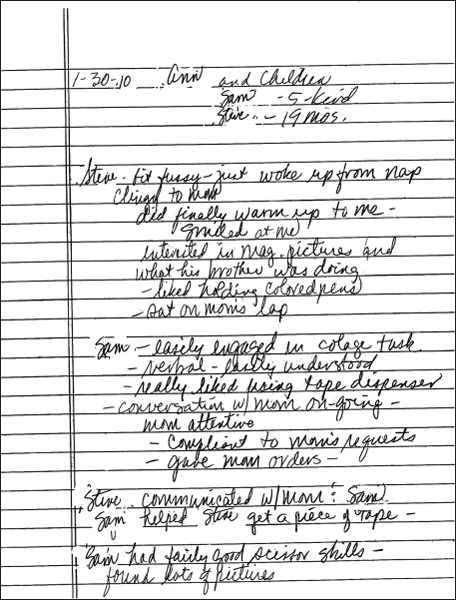
Questions to Consider: Mother and Children
1. Was Ann able to control both children during the activity? Was she able to keep them engaged in appropriate behaviors?
2. Did Sam engage in the activity?
3. What were the interactions between Ann and Sam during the activity?
4. What were the interactions between Ann and Steve during the activity?
5. What were the interactions between Sam and Steve during the activity?
6. How would you describe the relationship that Sam had with his mother?
7. How would you describe the relationship that Steve had with his mother?
8. How would you describe the relationship that Sam and Steve had with each other?
9. What was the feeling in the room when they were working on the activity?
10. What do you know about Sam and Steve from your observations?
Now see whether your responses to the questions matched the thinking of the evaluator. Remember: The evaluator had the advantage of doing the actual observation, so your responses may be different depending on the quality of the evaluator’s notes. However, your responses should be at least close to the evaluator’s.
Questions to Consider: Mother and Children/Evaluator’s Answers
1. Was Ann able to control both children during the activity? Was she able to keep them engaged in appropriate behaviors?
Ann easily handled the two children. Steve started out a bit fussy, having just awakened from a nap, but he warmed up as time went on. Sam was compliant with his mother’s requests and was engaged in the activity, as was Steve (for his developmental level).
2. Did Sam engage in the activity?
Sam was very engaged in the activity. He found many pictures, liked taping them on the paper, and seemed to enjoy the creativity of the task. He talked throughout the activity to both his mother and his brother.
3. What were the interactions between Ann and Sam during the activity?
Ann and Sam talked with each other throughout the activity. Their conversation was easy and flowed well. Sam was compliant with his mother’s requests. He also felt comfortable enough with his mother to give her instructions. Ann was compliant with his requests and was very attentive to him and to his words and actions. Ann had an easy relationship with Sam.
4. What were the interactions between Ann and Steve during the activity?
Ann and Steve interacted with each other appropriately. At first Steve clung to Ann and sat on her lap. As time went on, he sat in his own chair and participated in the activity to the extent of his ability. Ann responded to Steve’s requests, encouraging him and praising him appropriately. Ann had an easy relationship with Steve.
5. What were the interactions between Sam and Steve during the activity?
Sam and Steve interacted with each other: Sam helped his brother get tape, gave him colored pencils to hold, and talked to him. Sam seemed to understand what Steve wanted and was compliant with his requests. The boys had an easy relationship with each other.
6. How would you describe the relationship that Sam had with his mother?
The relationship was functional, loving, and comfortable. Sam related to his mother very easily. He engaged her in conversation and engaged with her in performing the task. Everyone helped everyone else. Sam loves his mother very much, and she loves him.
7. How would you describe the relationship that Steve had with his mother?
Steve had a loving and comfortable relationship with his mother. He looked for her to comfort him when he was fussy and looked to her for assistance with the tape and for attention when he needed it. They engaged in conversation. Steve was happy to be there with his mother and his brother. Steve loves his mother very much, and she loves him.
8. How would you describe the relationship that Sam and Steve had with each other?
Sam and Steve interacted easily with each other during the task. Sam was helpful to his brother and was compliant with his requests. They shared well, didn’t grab objects out of each others’ hands, and got along well with each other. Sam was protective of Steve. He appears to take his job of big brother seriously.
9. What was the feeling in the room when they were working on the activity?
The feeling was a good one. There was no tension or anxiety. Everyone got along with everyone. There was humor in the conversations. Both boys and Ann were relaxed and enjoyed the task.
10. What do you know about Sam and Steve from your observations?
Sam and Steve are bonded with each other, as they also are with their mother. Sam is a nice boy and feels comfortable with his mother. He is protective of his brother and his mother. He tries hard to please and do a good job. He is meticulous in his work. Sam is developmentally appropriate with his language and motor skills. He is a nice boy and would be easy for a counselor to work with. Steve is also developmentally appropriate for his age. He is curious and acts independently in his environment. He has excellent receptive language and appropriate expressive language skills and is confident that both his mother and Sam will understand what he needs and will provide for him. He is a nice boy and is developing positively.
CHILD INTERVIEW
After this part of the appointment, Ann and Steve were asked to leave the room, and the evaluator and Sam spent some time together one on one. This part of the appointment lasted approximately 40 minutes. Sam was not reluctant to stay alone with the evaluator and engaged in conversation easily. He seemed comfortable and interacted with the evaluator appropriately.
The evaluator began by asking about the collage Sam had made, talking about the pictures and why Sam chose those particular ones. The evaluator then told him what she knew about him, including his grade in school, that he did well in school, and that he had friends (she asked about their names). Then she tried to guess Sam’s favorite subject in school. She guessed correctly after two tries. Sam was impressed with the evaluator’s skills (as are virtually all children). Sam was easy to develop rapport with and was willing to talk openly with the evaluator. Sam was a really nice boy to be around.
The evaluator asked Sam whether he knew why he was there talking to the evaluator. He said that it was because his mother and father fought and couldn’t get along with each other. The evaluator agreed and told him that because his mother and father couldn’t get along well enough to decide how they would both see the children, they hired the evaluator to help them make decisions; because Sam was part of the family, the evaluator wanted to talk with him to hear what he thought of the situation and find out whether he had any ideas about how to make his life easier. Sam thought this was a good idea. The evaluator told Sam that she was working for him, so he was the boss and the evaluator his employee. Sam really liked that idea.
The following notes were written by the evaluator after the appointment with Sam:

Sam began to talk immediately about how much he hates being at his father’s house. At first, he had to sleep in a room in the basement, and that scared him. His father finally moved him into a room upstairs next to his own room, which they had reserved for Steve. Sam likes that better and doesn’t feel as afraid.
Sam gets along with three of Linda’s four children, but the 8-year-old boy, Roy, is always mean to Sam and gets him into trouble all the time. Sam also doesn’t like Linda: She makes him eat food he doesn’t like and always sides with Roy against him. She likes her children, but she doesn’t like Sam. She wants everyone to only do the things her children want to do.
Sam misses his mother when he is at his father’s. He believes 4 days with his mother to be too few and 3 days with his father to be too many. He worries about his mother and Steve when he is not with them. He is afraid that his father won’t let him leave with his mother when it is time for him to go to her house. He feels afraid and sad and mad when he is at his father’s.
Sam told the evaluator that he once saw his father hurt his mother. He said so first thing and then didn’t want to talk about it anymore. The comment was odd in happening first, as if Sam wanted to get it out of the way. Sam agreed that he was scared when it happened, then moved on to other topics. The evaluator wonders whether he was coached by his mother or whether he thought this was what he was supposed to talk about based on his prior experience with an evaluator. Further thought is needed on this topic and Sam’s involvement.
Here are some questions to consider regarding the interview with Sam:
Questions to Consider: Child
1. Who does Sam view as his primary caregiver?
2. What is Sam’s experience at his mother’s house?
3. What is Sam’s experience at his father’s house?
4. How does Sam relate to Linda’s children?
5. How does Sam relate to Linda?
6. What does Sam want for a custody and visitation schedule?
Questions to Consider: Child/Evaluator’s Answers
1. Who does Sam view as his primary caregiver?
Sam views his mother as his primary caregiver. Steve is too young to speak, but he is certainly bonded with his mother.
2. What is Sam’s experience at his mother’s house?
Sam feels comfortable and safe at his mother’s house. He doesn’t like change in his life. At his mother’s home—the family home—he is in familiar surroundings and has all his things.
3. What is Sam’s experience at his father’s house?
Sam feels uncomfortable, worried, anxious, and afraid at his father’s house. He is picked on by the other children and often gets in trouble. He believes that Linda sides with her children and doesn’t like him. When he is at his father’s house, he worries about his mother and brother.
4. How does Sam relate to Linda’s children?
He gets along with three of the four children, but Roy, the 8-year-old, picks on him and gets him into trouble. He feels left out and unliked by the other children.
5. How does Sam relate to Linda?
He believes that she doesn’t like him and that she treats him differently from how she treats her own children. She is mean to him. She also makes his father do what she wants him to do rather than letting him spend time with Sam.
6. What does Sam want for a custody and visitation schedule?
Sam wants more time with his mother and less time with his father. He misses his mother when he is at his father’s house—he wants to go home. He is afraid that his father won’t let him leave with his mother when it is time for Sam to go with her.
FATHER AND CHILDREN INTERVIEW
The last appointment was with Bob and the children, approximately 2 weeks after Bob and Linda’s appointment. Sam remembered the evaluator and showed Bob to the room where Sam and Steve had worked previously with their mother. Sam was eager to begin the collage activity with his father. The evaluator asked whether Sam could give his father instructions, which he did; then they began the activity. Steve was also interested in what was going on and wanted to play with the tape. Bob had brought food and drink for Steve to eat since it was close to lunchtime. This portion of the appointment lasted approximately 40 minutes.
After considering the notes taken during this portion of the appointment, see whether you can answer the following questions:
Father and Children Interview Notes
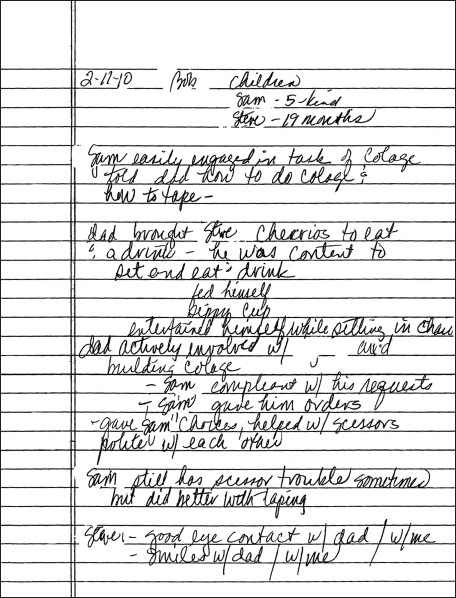
Questions to Consider: Father and Children
1. Was Bob able to control both children during the activity? Was he able to keep them engaged in appropriate behaviors?
2. Did Sam engage in the activity?
3. What were the interactions between Bob and Sam during the activity?
4. What were the interactions between Bob and Steve during the activity?
5. What were the interactions between Sam and Steve during the activity?
6. How would you describe the relationship that Sam had with his father?
7. How would you describe the relationship that Steve had with his father?
8. How would you describe the relationship that Sam and Steve had with each other?
9. What was the feeling in the room when they were working on the activity?
10. What do you know about Sam and Steve from your observations?
Questions to Consider: Father and Children/Evaluator’s Answers
Here are the evaluator’s thoughts about the questions. Now that you are getting the hang of this, your answers are probably similar.
Bob was able to handle both children during the activity. He kept them both engaged in the activity. He showed patience in his interactions with both Sam and Steve. He encouraged and praised them both appropriately.
2. Did Sam engage in the activity?
Yes, Sam engaged in the activity and encouraged his father to be an active participant as well.
3. What were the interactions between Bob and Sam during the activity?
Bob and Sam talked throughout the activity. Sam was compliant with his father’s requests and felt comfortable enough to give his father instructions. His father was compliant with Sam’s requests. They had fun together and conversed with each other easily.
4. What were the interactions between Bob and Steve during the activity?
Bob and Steve interacted well together. Bob helped him draw and participate. Bob was very patient with Steve, giving him appropriate praise and encouragement.
5. What were the interactions between Sam and Steve during the activity?
Again, Sam helped Steve with the tape. Sam waited for his father’s attention when Bob was dealing with Steve. Sam talked to Steve often during the activity.
6. How would you describe the relationship that Sam had with his father?
Sam and his father have a good relationship with each other. They appear bonded and easily interact with each other. They use humor with each other and have an easy relationship.
7. How would you describe the relationship that Steve had with his father?
Steve also appeared bonded with his father. He had good eye contact with his father. He depended on his father to fulfill his requests. He smiled a lot at both Sam and his father.
8. How would you describe the relationship that Sam and Steve had with each other?
The relationship between Sam and Steve was similar to what happened during the appointment with Ann. They related well with each other. Sam was willing to help Steve participate in the activity. Both boys shared well with each other.
9. What was the feeling in the room when they were working on the activity?
There was a good feeling in the room during the activity. Everyone got along and seemed happy to be with each other. There was a sense of a solid relationship between the boys and their father.
10. What do you know about Sam and Steve from your observations?
Both of the boys are good children and easy to be around. The evaluator drew the same conclusions about the boys during this appointment that she did from the appointment with their mother.
CHILD INTERVIEW
As before, Bob and Steve were asked to leave the room. Sam was fine with staying alone with the evaluator, who started by talking about the collage Sam had built with his father. Then Sam talked about what he and his father were going to do together that day. He was very happy that he and Steve and their father were going to spend the day alone together. He wished that his father would spend more time alone with him. He was happy when he was with his father and unhappy when his father spent most of his time with Linda and her children.
Here are the notes from this portion of the appointment. Read them and then answer the following questions:
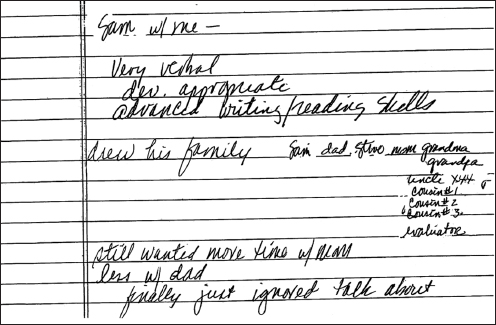
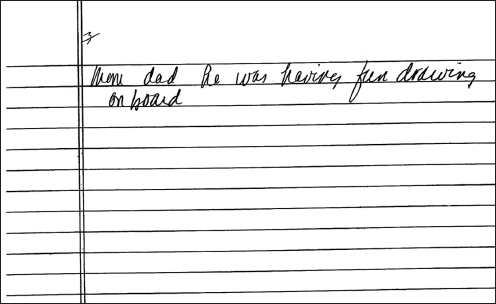
1. Who does Sam view as his primary caregiver?
2. What is Sam’s experience at his mother’s house?
3. What is Sam’s experience at his father’s house?
4. How does Sam relate to Linda’s children?
5. How does Sam relate to Linda?
6. What does Sam want for a custody and visitation schedule?
Questions to Consider: Child/Evaluator’s Answers
Here are the evaluator’s answers:
1. Who does Sam view as his primary caregiver?
Sam remains consistent in viewing his mother as the primary caregiver.
2. What is Sam’s experience at his mother’s house?
Again, he remains consistent in feeling most comfortable at his mother’s house.
3. What is Sam’s experience at his father’s house?
Sam didn’t change his opinion about being at his father’s house from the first time the evaluator talked with him.
4. How does Sam relate to Linda’s children?
This, too, remains consistent from the first interview.
5. How does Sam relate to Linda?
Again, there is no new information about his feelings toward Linda. Nothing has changed since the first discussion with the evaluator.
6. What does Sam want for a custody and visitation schedule?
Sam still wants more time with his mother and less time at his father’s house.
Sam remained consistent in wanting more time with his mother and less time at his father’s house. He still didn’t like it at his father’s house—he didn’t like Linda, and he didn’t like her children. His feelings remained consistent about his father’s house and his mother’s house. He said he had thought about the previous one-on-one discussion and still wanted his family together, but if that couldn’t happen then he wanted to spend his time with his mother and spend alone time with his father. But he didn’t think that alone time with his father was going to happen, because Linda wanted his father to do things with her and her children.
Then, as often happens, Sam was done talking about his mother and his father. He began to draw on the board. He drew his family, including his parents, his brother, his grandparents, his uncle, and his cousins. He also included the evaluator at the end of the line of people. He did not include Linda or her children. He talked about how he plays with his cousins and his friends. He enjoyed drawing on the board while talking about what he likes to do for fun. Although Bob and Linda agreed that Sam liked to go to Linda’s children’s competitions, Sam did not mention doing that as something that he enjoyed doing.
Now you have a feeling for the children and the parents. You understand how each home operates and how the children fit into each home. You also understand how successful the blending of the two families at Bob’s home is both from Bob’s perspective and from Sam’s perspective. You know what the relationships are like between the children and each parent. You also know what Sam wants in order for his life to be better, what the parents want in terms of custody and visitation, and what might meet the best interests of the children.
COLLATERAL CONTACTS
Next is the information gathered from the collateral contacts and the collateral documents. Let’s start with the collateral contacts, including Sam’s current counselor and both the children’s daycare providers. The first notes are those taken when the evaluator talked with Sam’s counselor on the telephone:
Collateral Contacts: Child’s Counselor Notes
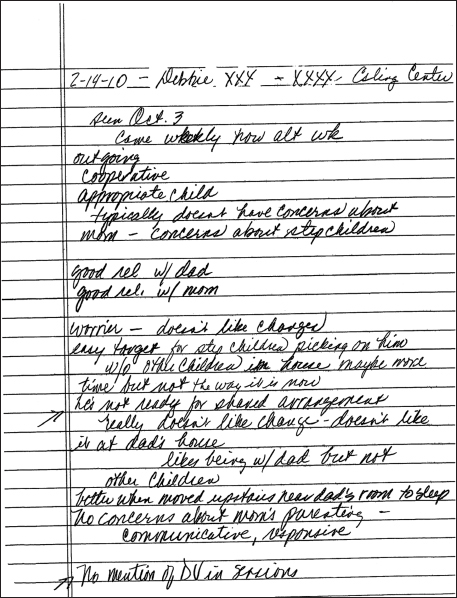
Questions to Consider: Collateral Contact—Child Counselor
Now that you have read the notes, answer the following questions:
1. Do Sam and the counselor have a good therapeutic relationship?
2. Is the counselor’s interpretation of Sam similar to what you have concluded?
3. What is the counselor’s perspective of both parents and of Sam’s relationship with them?
4. Did the counselor have any concerns about either parent’s skills as a parent to Sam?
5. Did the counselor have an opinion about what custody and visitation schedule would work best for Sam?
Questions to Consider: Collateral Contact—Child Counselor/Evaluator’s Answers
Here’s how the evaluator answered these questions.
1. Do Sam and the counselor have a good therapeutic relationship?
Yes, Sam and his counselor do have a good therapeutic relationship. They have engaged in counseling for more than 3 months. He is a cooperative and appropriate child in therapy.
2. Is the counselor’s interpretation of Sam similar to what you have concluded?
Yes, the counselor describes Sam the way the evaluator sees him. He is a nice boy but struggles with change. He is anxious and a worrier. He doesn’t like it at his father’s house. He doesn’t get along with Linda’s children. He is an easy target for the other children to pick on.
3. What is the counselor’s perspective of both parents and of Sam’s relationship with them?
The counselor describes both parents as having good parenting abilities. She has had more contact with Ann but believes that Sam has a good relationship with both his parents. He likes spending time with both his parents. He wants more time alone with his father without the other children or Linda around.
4. Did the counselor have any concerns about either parent’s skills as a parent to Sam?
No, she didn’t have any concerns about the parents’ abilities to parent Sam. She did worry that Bob is not spending quality time with Sam.
5. Did the counselor have an opinion about what custody and visitation schedule would work best for Sam?
Yes, she was opposed to a shared arrangement at this time. She thought that more time with Bob would be fine so long as Linda’s children were not present. She believed that Ann was the primary caregiver for the children.
The next collateral contacts were the children’s daycare providers. Both conversations were relatively short but revealed important information. After reading the notes, answer the following questions:
Collateral Contacts: Daycare Providers’ Notes
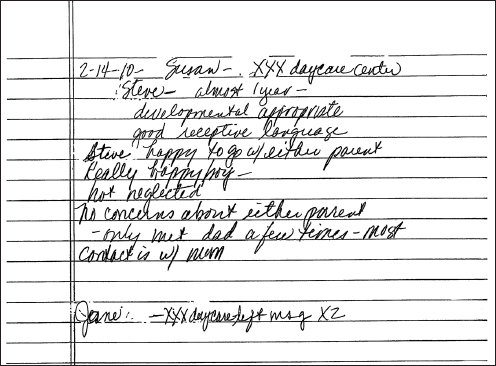
Questions to Consider: Collateral Contact—Daycare Providers
1. Are the children well cared for, or do they appear neglected?
2. Do the children have a good relationship with both parents?
3. Do the children act appropriately at daycare?
4. Have there been any noticeable changes in either child since the breakup of the family?
Questions to Consider: Collateral Contact—Daycare Providers/Evaluator’s Answers
Here is how the evaluator answered the questions; your answers should be similar.
1. Are the children well cared for, or do they appear neglected?
Both children are well cared for and do not seem neglected. They are clean, well-fed, happy children.
2. Do the children have a good relationship with both parents?
Yes, they seem to have a good relationship with both parents. Both child care providers had more contact with Ann (contrary to what Bob said in his interview). The children go with either parent willingly when picked up.
3. Do the children act appropriately at daycare?
Yes. They are good children and do not cause disruption at the daycare facility. They both appear to be developmentally appropriate.
4. Have there been any noticeable changes in either child since the breakup of the family?
Sam has had more accidents since the breakup of the family. He both urinates and defecates in his pants more often. This is a change in his behavior. He also appears to be more anxious and worried since the breakup.
Collateral Contacts: Documentation
Now let’s consider the documentation that was submitted to the evaluator to consider. First, let’s start with the mini-evaluation that was completed approximately 3 months before the full evaluation was ordered. The purpose of this evaluation was to give recommendations for temporary custody and visitation. It was hoped that the mini-evaluation would resolve the problems between the parents so that they could then develop a parenting plan without further involvement from the court.
Collateral Contact: Prior Evaluation
The prior mini-evaluation was 14 pages long and contained details about the parents, the children, and the parents’ respective homes. It also gave recommendations for custody and visitation. Unfortunately, numerous problems with the report and its recommendations did little to help the full evaluation process.
This mini-evaluation included discussion of both parents’ skills and relationships with the children. It also included the role of Linda in Bob’s home. The evaluator stated in the report that she had met with both parents, with both children, and with both parents together with their children and that she had made telephone contacts with the collateral contacts provided by each parent, in addition to making in-home visits. The inaccuracies in the report start at its beginning: This evaluator did not get the timeline correct after Bob moved out of the family home. Next, the report dwelled on both parents’ accusations of the other’s infidelities before the separation. This was questionable—what an evaluator needs to deal with is the reality of the present situation of the children and their parents.
The report discusses at length in-home visits to the mother’s home. The evaluator verified that there were broken doors and holes in walls and had Sam show her where his father used to keep his beer in the garage. She also talked privately to Sam twice in his mother’s home. These interviews focused on having Sam tell her about the domestic violence he had observed between his mother and father. The evaluator also had Sam discuss living at his father’s home and how he hated it and felt scared there. He also talked about how Linda treated him and the other children and said that he didn’t like her or like being at his father’s house. The evaluator asked Sam to tell her about how Steve was treated at Bob’s home by Linda. Bob later called these interviews interrogations. Perhaps it was just how these conversations were written—but they did sound a bit like interrogations of Sam.
The report then goes on to tell how Bob tried to intimidate the evaluator into giving him shared custody of the children. The evaluator said she later received a call from Bob apologizing for making her feel as if he was intimidating her. The evaluator apparently did not believe the apology was heartfelt—the report listed this as a continued cause for concern during the evaluation. Did events happen as the evaluator described, or was the evaluator too sensitive? This will remain unknown.
The report details the evaluator’s in-home visits in both parents’ homes. It was later revealed that the visits in Ann’s home were quite exhaustive, but the visit at Bob’s home was not. The evaluator went through the entire house and garage at Ann’s but simply sat on the couch in one room at Bob’s. She then developed her conclusions despite the inequities in her visits. This is never a good idea. What the evaluator does for one parent he or she should replicate for the other.
Before providing recommendations, the report described the evaluator’s collateral contacts. However, Bob’s contacts were not contacted by the evaluator. Furthermore, the report says that the evaluator saw the children with both their parents. This, too, was untrue—she only saw the children with their mother.
The lessons to learn from this report are numerous. If you didn’t contact someone, then don’t say you did. Also, treat both parents fairly—and equally. Do not write a report that seems to favor one parent over the other. Treat both parents the same. Additionally, do not perseverate on one aspect of the situation. The evaluator was determined to make Sam and Ann’s allegations of domestic violence a major factor in her recommendations to the court. But many factors must play into reasonable recommendations. Finally, your recommendations must make sense and be consistent with your previous discussion in the report. If the evaluator writes that Bob is prone to domestic violence, then the recommendations should reflect how the children will be protected when they are with him. Consider whether this evaluation’s recommendations do that.
The recommendations given to the court by the mini-evaluation were for longer than the 3-month temporary custody and visitation schedule required by this type of evaluation. The recommendations for the best interest of the children included a week/week shared arrangement for both children during the summer months. Also included was a 2-week extended vacation period for Bob during the summer. If Bob was prone to violence, Linda a poor stepparent, and Sam not fitting in with Linda’s children and feeling troubled about being at his father’s home for long periods, then why would a shared arrangement be in Sam’s best interest? Steve is far too young to be away from his primary caregiver and his primary home. A week away (and 2 weeks on one occasion) from his mother is far from being in his best interests.
During the school year, it was recommended that the children visit their father on alternate weekends from Friday evening to Sunday evening. Again, this is not reasonable for a child of Steve’s age. It does make more sense for Sam and his best interest. A holiday schedule for the entire year was also included.
Ultimately, Bob and his attorney requested that the court exclude this report and order a full evaluation with another evaluator agreed upon by both parents. The attorney provided the court with affidavits from those people not contacted and an affidavit from Bob stating he that was not involved with the children during the evaluation, as well as with other pieces of evidence that in aggregate persuaded the court to exclude the report.
Collateral Contact: Prior Evaluation/Evaluator’s Answers
In regard to the current evaluation, the first mini-evaluation was not particularly helpful except in verifying the consistency in which Sam spoke of his father’s home, his feelings about being at his father’s house, his feelings about and experiences with Linda and her children, and his mother’s being his primary caregiver. These issues could have been discovered without reading the first mini-evaluation.
Collateral Contact: Father’s Deposition
Another document provided to the evaluator was the deposition of Bob taken prior to the order of the current evaluation. This 57-page document provided little, if no, additional information relevant to the children’s best interests. Finally, Ann provided nude pictures of Linda she acquired on the Internet. She provided other pictures, also available on the Internet, showing Linda, Bob, Linda’s children, and Bob’s children as one big happy family. Again, neither of these collateral pieces provided information particularly relevant to the children’s best interests.
EVALUATOR’S CONSIDERATIONS FOR RECOMMENDATIONS
Now it is the job of the evaluator to decide what information is important to writing appropriate recommendations and what information is irrelevant to the primary purpose. Four main pieces of information that will provide a map to writing the recommendations are: (1) Steve’s age; (2) Sam’s feelings about his father’s house, particularly Linda and her children; Sam’s regression, evident in his return to urinating and defecating in his pants; Sam’s constant worry about what will happen to him, his brother, and his mother; and Sam’s inability to cope with change and stress; (3) Ann’s role as the primary caregiver for the children; and (4) both children’s good relationship with both their parents.
The other information, including Bob’s alcohol use and alleged domestic violence, infidelity on one or both parents’ parts, Linda’s past with men and subsequent four children, availability of nude pictures of Linda on the Internet, and Linda’s apparent lack of understanding of the role of a stepparent, are certainly part of this case, but they are not the driving forces behind your recommendations to the court. You may find some of these things offensive, but your job is to write recommendations that are in the children’s best interest, nothing more.
The following are the recommendations the evaluator provided to the court. You should be able to understand how the evaluator came to these recommendations and how the recommendations protect the children’s best interests.
REPORT SUBMITTED TO THE COURT/SMITH VS SMITH
RECOMMENDATIONS OF CUSTODY AND VISITATION OF THE SMITH CHILDREN
RE: SMITH VS SMITH
CASE NO.: CV-2010-0000-DR
DATE: MARCH 20, 2010
1. Joint custody of Sam Smith and Steve Smith be awarded to both parents, Ann Smith and Bob Smith.
2. It is recommended that both children live mostly with their mother, Ann Smith, while visiting regularly with their father, Bob Smith:
a) Bob would have visitation with Sam on alternate weekends from Friday after school to Monday morning, when he will return him to school. Long weekends during the school year would generally be awarded to Bob. For example, on a 3-day holiday weekend, Bob would have visitation from Friday after school to Tuesday morning, when he returns Sam to school. On teacher in-service weekend, Bob would have visitation from Thursday morning to Monday morning. Additionally, on the alternate week (the week without overnights), Bob would have two evening visits from after school until 7 p.m. The parents can negotiate the days and times for the evening visit. It is assumed that Bob will be available to care for Sam when he has visitation on the weekends and midweek.
b) Bob would have visitation with Steve on alternate Saturdays from 10 a.m. to 6 p.m. and alternate Sundays from 10 a.m. to 6 p.m. On the alternate week, Steve would be with his father when Sam is with his father for the alternate week evening visits. It is assumed that Bob will be available to care for Steve when he has visitation on the weekend days and during the midweek visits.
c) Summer visitation would remain the same but with the addition of 4 additional overnights with Sam (7 consecutive overnights) twice during the summer months. It is the responsibility of whichever parent is using the extended time to inform the other parent at least 4 weeks before doing so. Furthermore, it is assumed that Bob will be available for child care during the extended times.
d) Summer visitation for Steve would remain the same but with the addition of 3 consecutive overnights twice during the summer months. It is the responsibility of whichever parent is using the extended time to inform the other parent at least 4 weeks before doing so. Furthermore, it is assumed that Bob will be available for child care during the extended visitation time.
e) Holidays can be split or alternated as negotiated by the parents. Christmas day can be split or alternated. The remainder of the Christmas holiday time can be split between the parents for up to 4 consecutive overnights. Spring break would be awarded to Bob for up to 4 consecutive overnights.
f) Regular phone contact needs to be established between the children and their parents. The parents can negotiate the time for this daily contact. Both parents are responsible for facilitating this phone contact.
g) Both parents have the right of first refusal for child care.
h) Travel will be shared equally between the parents.
3. Sam would benefit from regular individual counseling. He is currently seeing a counselor on a biweekly basis. This should continue, perhaps even on a weekly basis. The counselor is encouraged not only to meet with Sam but also to meet with Sam with his father and Sam with his mother. The father–son counseling sessions will help Sam resolve his feelings about the divorce and help him understand that his father loves him and has not replaced him with Linda’s children. The mother–son counseling sessions will help Sam separate from his mother more easily and believe that he can be autonomous in his life. Counseling will also help Sam deal with his anxiety and worries about his current life.
4. Sam would benefit from being part of an extracurricular activity such as soccer, tee-ball, or swimming. Sam needs an outlet where he can be a part of a team and see himself as a positive asset to that team. Both parents would be responsible for facilitating his attendance at practice and games. Both parents would equally share the costs associated with the extracurricular activity.
5. Both parents and the “stepparent” would benefit from parent education/divorce education classes. Potential referrals include the X Counseling Center, the Y Counseling Center, and Z Counseling.
6. Bob would benefit from counseling services to help him better understand any anger issues he may have. Counseling would also help him understand how to be an effective coparent. Possible referrals are ABC Counseling and XYZ Counseling.
7. Ann would also benefit from counseling services to help her learn how to better identify and deal with her emotions concerning the divorce. She will also learn skills that will make her a better coparent. Possible referrals are the XYZ Counseling Center or Dr. Smith (private practice).
8. A regular time each week needs to be established for the parents to communicate with each other about the children. This communication can be over the phone or face-to-face. The parents can negotiate the day and time for this weekly communication opportunity.
9. Because of Steve’s age and Sam’s emotional immaturity, a shared arrangement at this time is not recommended. A reevaluation should be conducted just before Steve enters kindergarten to determine whether a shared arrangement would then be in the children’s best interests. It is hoped that the parents can make any necessary modifications; however, if they are unable to do so, then a formal reevaluation would be necessary and would consider the parents’ abilities to communicate effectively and coparent efficiently. A formal reevaluation would also consider both children’s best interests and positive growth and development, as well as the parents’ current living arrangements.
